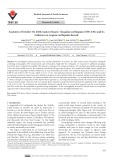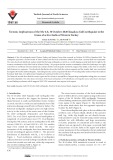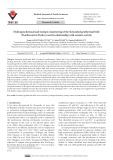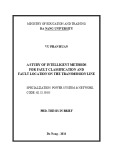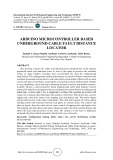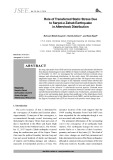
Fault location
-
This article introduces a method which could quickly delineate short-circuit fault location by establishing the corresponding matrix between nodes on grid and short circuit current value. A 22kV Daklak distribution grid – E471 line is studied. A big data of input as load, source, season coefficient, utilization coefficient and all four types of short circuit have been considered and calculated in detail.
 7p
7p  vidoctorstrange
vidoctorstrange
 06-05-2023
06-05-2023
 8
8
 2
2
 Download
Download
-
Understanding the tectonic mechanism generated by the earthquakes and faults is possible only if the preseismic, coseismic and postseismic crustal deformation related to the earthquakes is determined properly. By the analysis of continuous GPS (CGPS) coordinate time series, it is possible to estimate the crustal deformation. Besides, accelerometer records at strong motion stations (SMSs) may support the CGPS-based estimates.
 18p
18p  tanmocphong
tanmocphong
 29-01-2022
29-01-2022
 17
17
 2
2
 Download
Download
-
We investigated rupture geometry, size, and slip distribution of October 30, 2020, Samos (Sisam)–Kuşadası earthquake combining seismographs, GPS measurements, and SAR analysis. Right after the earthquake, we measured 13 additional campaignbased GPS sites to intensify the available GPS network consisting of 10 continuous stations. We combined all available seismographs to have the best possible accuracy for mainshock and aftershock hypocenter locations. We compiled all available seismic profiles and integrated them using high-resolution bathymetry to map seismically active faults.
 11p
11p  tanmocphong
tanmocphong
 29-01-2022
29-01-2022
 13
13
 1
1
 Download
Download
-
A Mw 6.8 earthquake struck Western Turkey and Eastern Greece that occurred on October 30, 2020 in Kuşadası Gulf. The earthquake epicentre is located north of Samos Island and the focal mechanism solution shows that a normal fault was reactivated. The main shock and aftershock analysis imply that the large earthquake occurred on a north dipping normal fault which might be the western continuation of the Efes Fault in Western Turkey.
 13p
13p  tanmocphong
tanmocphong
 29-01-2022
29-01-2022
 10
10
 1
1
 Download
Download
-
Kestanbol geothermal field is located in northwestern Turkey and is one of the highest temperature geothermal fields in the Biga Peninsula. In this study, one geothermal well, two geothermal springs, and two cold springs were monitored for one year in Kestanbol geothermal field to determine hydrogeochemical and isotopic characteristics. Additionally, any possible relationship between seismic activity and variations in the hydrochemistry of geothermal water was investigated.
 22p
22p  tanmocphong
tanmocphong
 29-01-2022
29-01-2022
 15
15
 1
1
 Download
Download
-
The thesis contributes on quick solving a big amount of work, which is in fault classification and location at the request of the Power Sector. Besides, the thesis supplies the knowledge supporting for operation, increasing the effectiveness of relay’s utilization.
 28p
28p  guitaracoustic02
guitaracoustic02
 08-12-2021
08-12-2021
 16
16
 2
2
 Download
Download
-
The growing concern for safety and infrastructural proliferations in the densely populated urban and suburban areas as well as the quest to preserve the aesthetic values in many modern localities have necessitated the need for underground installations.
 13p
13p  lucastanguyen
lucastanguyen
 01-06-2020
01-06-2020
 20
20
 2
2
 Download
Download
-
There is a good correlation between Coulomb stress changes and aftershocks distribution in Sarpol-e Zahab event. Furthermore, calculated static stress on the surrounding faults showed that middle part of the High Zagros Fault (HZF), the northern part of the Main Recent Fault (MRF), and the northern part of the Zagros Foredeep Fault (ZFF) are located in the positive stress change area.
 8p
8p  meriday
meriday
 20-04-2019
20-04-2019
 10
10
 1
1
 Download
Download
-
Locating fault equipment If BSC has fault, usually it will affect some Sites or all of Sites If BTS has fault, usually it just affect itself and the handover success rate of adjacent cells During implementation or expansion, we can “Interchange ” BTS and judge whether the fault is because of BSC or BTS During maintenance, BSC faults don’t just affect one BTS
 46p
46p  daihocdientu4
daihocdientu4
 20-05-2013
20-05-2013
 59
59
 7
7
 Download
Download









